Mining the pastures of ChessBase 14
Davide Nastasio wanted to take his game to the next level. He bought ChessBase 14 along with Mega Database 2017 and started experimenting with it. He was amazed at the things he could do with these tools. After working for a few days, he realized that working with CB 14 and Mega 2017 allowed him to not only study master games, but also analyze them, learn from world class annotators and find out errors in his own game. He now shares his experience with you in this detailed review.
Chessbase 14 New features!
 I decided to step up my game to the next level, and one cannot be considered serious if he doesn't use all the technological means at his disposal for learning and improving. In this case, I decided I needed the latest version of the famous ChessBase database program. Previously I had ChessBase 12. I discovered that there are some new features in ChessBase 14 which are extremely useful. I made sure to also buy Mega Database 2017.
I decided to step up my game to the next level, and one cannot be considered serious if he doesn't use all the technological means at his disposal for learning and improving. In this case, I decided I needed the latest version of the famous ChessBase database program. Previously I had ChessBase 12. I discovered that there are some new features in ChessBase 14 which are extremely useful. I made sure to also buy Mega Database 2017.
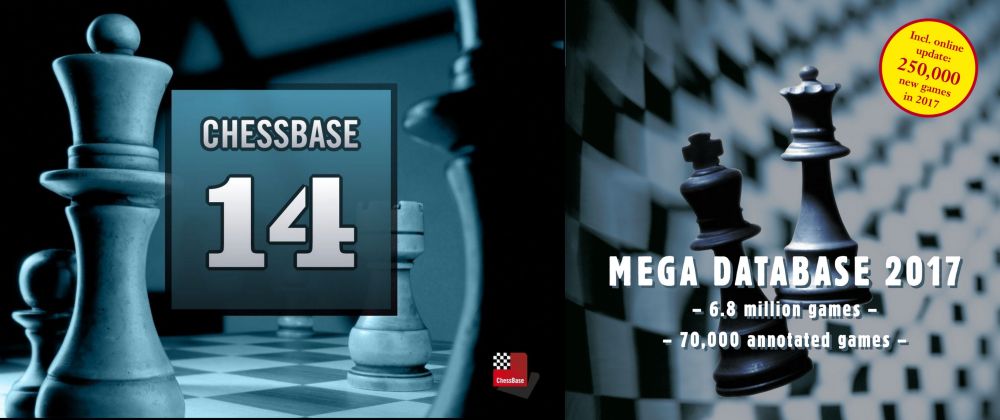
Mega Database is a database of all games played in the last 500 years. The first game present in the database is from 1475! The database has nearly seven million games, with regular updates, which keeps it current with new games, every other week especially for those who have an opening repertoire, and want to see if there are any novelties.
I would like to share my excitement, and outline some new features I found quite interesting in ChessBase 14.
One friendly GM recommended me to watch games with a big rating gap. Generally these games are played in open tournaments, where for reason of pairings the first and second rounds see players rated 1900-2100 playing against 2500-2700.
The grandmaster friend told me to watch at least 500 games with such a gap. I found some monthly collection of PGNs from latest tournaments, but it was tedious at best trying to find them. In chess at the moment we have a case of Too Much Information, or TMI, as GM Soltis likes to call it. You need a tool that sorts the data and gives you what you need.
With Chessbase 14, to find the games that I needed was just a matter of few clicks. Let me show you, how I did it! I opened my Mega Database 2017 and clicked on Filter list.

Then appeared the filter games mask, and I left the rating between 2500 and 3500 as it is, and clicked on "difference". I typed in 600, and clicked OK.
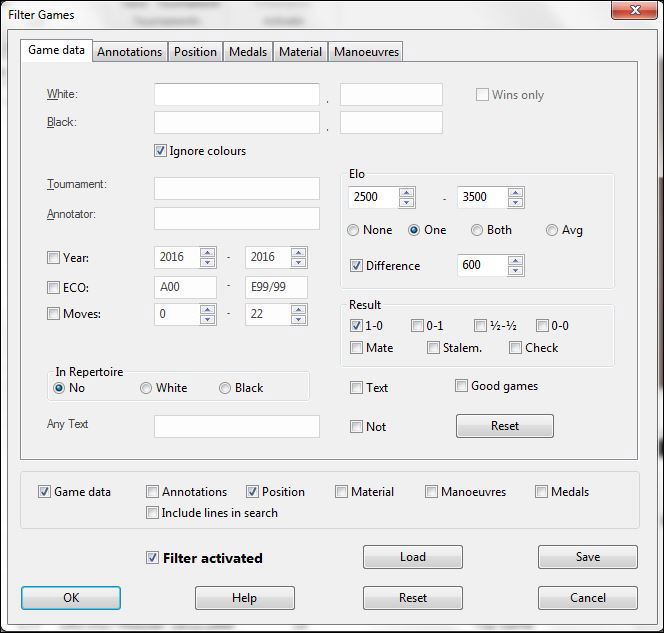
Surprise, surprise... in few seconds the Mega Database 2017, gave me over 8000 games to watch, which had such a rating gap!
Below is one of those games which I found particularly interesting, because the more I saw the game the more I realised how the GM had a better vision and calculation skills compared to the amateur, especially when evaluating the final position after many exchanges.
[Site "New York"]
[Date "1974.??.??"]
[Round "1"]
[White "Reshevsky, Samuel Herman"]
[Black "Le Grand, Mike"]
[Result "1-0"]
[ECO "E49"]
[WhiteElo "2542"]
[BlackElo "1751"]
[PlyCount "63"]
[EventDate "1974.08.??"]
[EventType "swiss"]
[EventRounds "12"]
[EventCountry "USA"]
[SourceTitle "EXT 2001"]
[Source "ChessBase"]
[SourceDate "2000.11.22"]
Ne2 e5 9. cxd5 Nxd5 10. O-O Nde7 11. Bb2 f5 12. c4 exd4 13. exd4 Ng6 14. f4 Qd6
15. Qc2 Nce7 16. d5 c5 17. Rae1 Bd7 18. Ng3 Rae8 19. Nh5 Rf7 20. Qc3 Nh4 21.
Nxg7 Qh6 22. g3 Rxg7 23. Qxg7+ Qxg7 24. Bxg7 Kxg7 25. gxh4 Kf6 26. Kf2 Rg8 27.
Rg1 Rf8 28. h5 Ng8 29. Rg3 Nh6 30. h3 Nf7 31. Rge3 Nd6 32. Re6+ 1-0

The funny thing of creating such a database is that I found upsets, like when a 1900+ rated player beats a former World Champion in a simul:
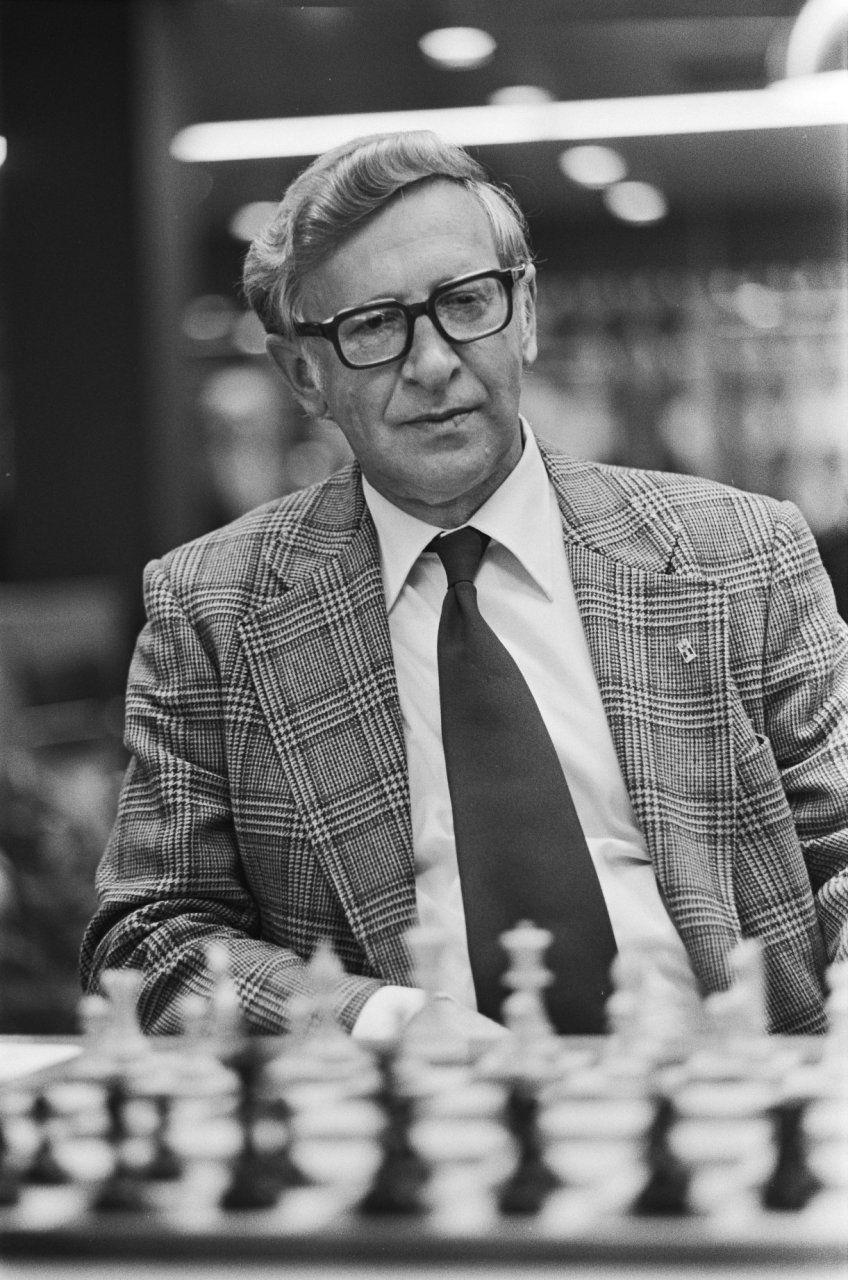
[Site "San Francisco"]
[Date "1976.03.20"]
[Round "?"]
[White "Smyslov, Vassily"]
[Black "Fong, Randy"]
[Result "0-1"]
[ECO "D32"]
[WhiteElo "2580"]
[BlackElo "1921"]
[PlyCount "82"]
[EventDate "1976.03.20"]
[EventType "simul"]
[EventRounds "1"]
[EventCountry "USA"]
[SourceTitle "EXT 2008"]
[Source "ChessBase"]
[SourceDate "2007.11.25"]
dxc5 Be6 9. Be2 Nbd7 10. O-O Nxc5 11. Nd4 Nce4 12. Nxe4 Nxe4 13. Bxe7 Qxe7 14.
f3 Nf6 15. Qd2 Rfe8 16. Rac1 Rac8 17. Rxc8 Bxc8 18. Rc1 a6 19. Bd3 g6 20. a3
Kg7 21. Kf2 Qe5 22. Kg1 Qxe3+ 23. Qxe3 Rxe3 24. Bf1 Bd7 25. Rc7 b5 26. Kf2 Re8
27. Ra7 Bc8 28. b4 Nd7 29. Nb3 Nb6 30. Nc5 d4 31. Nxa6 Re3 32. Nc5 Nc4 33. a4
Ra3 34. Rc7 Ra2+ 35. Kg3 Bf5 36. axb5 Ne3 37. b6 g5 38. Ne6+ Bxe6 39. f4 Nxf1+
40. Kf3 Bd5+ 41. Kg4 Ne3+ 0-1
Mr. Fong likely tried to repeat the exploit in another simul given by Smyslov, but this time the former World Champion was ready, and punished him quickly!
[Site "Walnut Creek"]
[Date "1976.03.21"]
[Round "?"]
[White "Smyslov, Vassily"]
[Black "Fong, Randy"]
[Result "1-0"]
[ECO "D09"]
[WhiteElo "2580"]
[BlackElo "1921"]
[PlyCount "93"]
[EventDate "1976.03.21"]
[EventType "simul"]
[EventRounds "1"]
[EventCountry "USA"]
[SourceTitle "EXT 2008"]
[Source "ChessBase"]
[SourceDate "2007.11.25"]
O-O-O 9. a3 d3 10. exd3 h4 11. Re1 hxg3 12. hxg3 Qxd3 13. b4 Nd4 14. Bb2 Nc2
15. Rc1 Nxe1 16. Qxe1 f6 17. c5 Qh7 18. c6 b6 19. Rc4 Be6 20. Rh4 Qc2 21. Rxh8
Qxb2 22. exf6 Ba2 23. Qe2 Qxa3 24. fxg7 Bxg7 25. Rh7 Bf6 26. Nf1 Bd5 27. Ne1
Qa2 28. Qg4+ Be6 29. Qf4 Be7 30. Nf3 Bd6 31. Qh4 Rf8 32. N3d2 Qb2 33. Bh3 Bxh3
34. Qxh3+ Kb8 35. Qe6 Qxb4 36. Rf7 Rc8 37. Ne4 a5 38. Rg7 Nh6 39. Rg6 Nf7 40.
Qxf7 Qxe4 41. Rxd6 Rh8 42. f3 Qc2 43. Qf6 Qc5+ 44. Kg2 Rh7 45. Rd2 Qh5 46. Qd8+
Ka7 47. Qc8 1-0
But the surprises are not finished. There are two players which are my favorites, one is Bronstein, the other Spassky.

We all know what's it like to crave for something that we like, something like chocolate or pizza or a donut. Similarly, in the last couple of days I felt the craving to watch Spassky's games! I wanted to watch exciting games. Like a collection of Spassky's gems. But such book has not been written. So what to do to satisfy this chess desire? Once more Chessbase 14 is where I turn to for satisfying this kind of craving!
I opened my trusted Mega Database 2017, opened the filter game mask (ctrl+f), wrote Spassky Boris in the "Game data" tab, and 1-0 as result, then I passed to the tab: position, and clicked on "sacrifice", and once more hit Ok!

Yes, Chessbase 14 can create the book of my dreams, at my request, with a few mouse clicks! Here is one of the games played by Spassky against another great player, whose name is used to describe one of the branches of the Sicilian, the famous Taimanov.
[Site "Moscow"]
[Date "1955.03.09"]
[Round "16"]
[White "Spassky, Boris Vasilievich"]
[Black "Taimanov, Mark E"]
[Result "1-0"]
[ECO "C70"]
[PlyCount "77"]
[EventDate "1955.02.11"]
[EventType "tourn"]
[EventRounds "19"]
[EventCountry "URS"]
[SourceTitle "URS-ch"]
f6 9. Nc3 Bb7 10. Nh4 Ne7 11. dxe5 dxe5 12. Qf3 Qd7 13. Rd1 Qe6 14. Be3 g5 15.
Nxb5 axb5 16. Qh5+ Qf7 17. Rxa8+ Bxa8 18. Rd8+ Kxd8 19. Qxf7 gxh4 20. Qxf6 Rg8
21. f3 h3 22. g3 Ke8 23. Qxe5 Rg6 24. Qxb5+ Bc6 25. Qb8+ Kf7 26. Qxc7 Rf6 27.
Bg5 Re6 28. b4 Kg8 29. Qb8 Ng6 30. Kf2 Ne5 31. b5 Be8 32. Be3 Bd6 33. Qc8 Kf7
34. b6 Rf6 35. Bf4 Bd7 36. b7 Be6 37. Bxe5 Bxe5 38. b8=Q Bxc8 39. Qxe5 1-0

I plan to create another database only of sacrifices played by Kasparov, once I finish studying the sacrifices by Bronstein and Spassky!
It's true that ChessBase 14 can give some amazing search results. But I don't use the new Chessbase 14 only for searches. I felt the need to read some books to help my improvement. One of these books was: My best games of chess 1908-1937, written by Alekhine.

I created a new database: Alekhine Best Games, and began manually (instead of taking the games from Mega Database) to input the games. Here I discovered a new feature. The new ChessBase 14 while inserting the moves highlights all the squares that the piece can go to. Each square has a different colour. Green is for good, orange - not so good, red is for bad, and when it becomes brown or black that means a checkmate is near, so that move shouldn't be played.
It's amazing how different hues of green, or orange show the goodness of the move. And this is important also for the opening. Here we can see how Chessbase 14 evaluates the different developing squares for the Ng1 and the Bf1.


Now, just for pleasure, I began to collect chess books, but let's say that I am on a trip, and cannot bring with me 200 pounds of books. How would I enjoy games annotated by Alekhine?
Yet again Chessbase 14, with Megabase 2017, gives me the possibility to have all chess knowledge on my computer. I open Mega Database 2017, go under the "Annotator" tab, and look for Alekhine, and I find 110 games annotated by him.
I select them all, copy them, and make a new database with just the games annotated by Alekhine. This is like a book written by Alekhine! Maybe better, as I can easily play over the moves on the screen, something which cannot be done in the book!
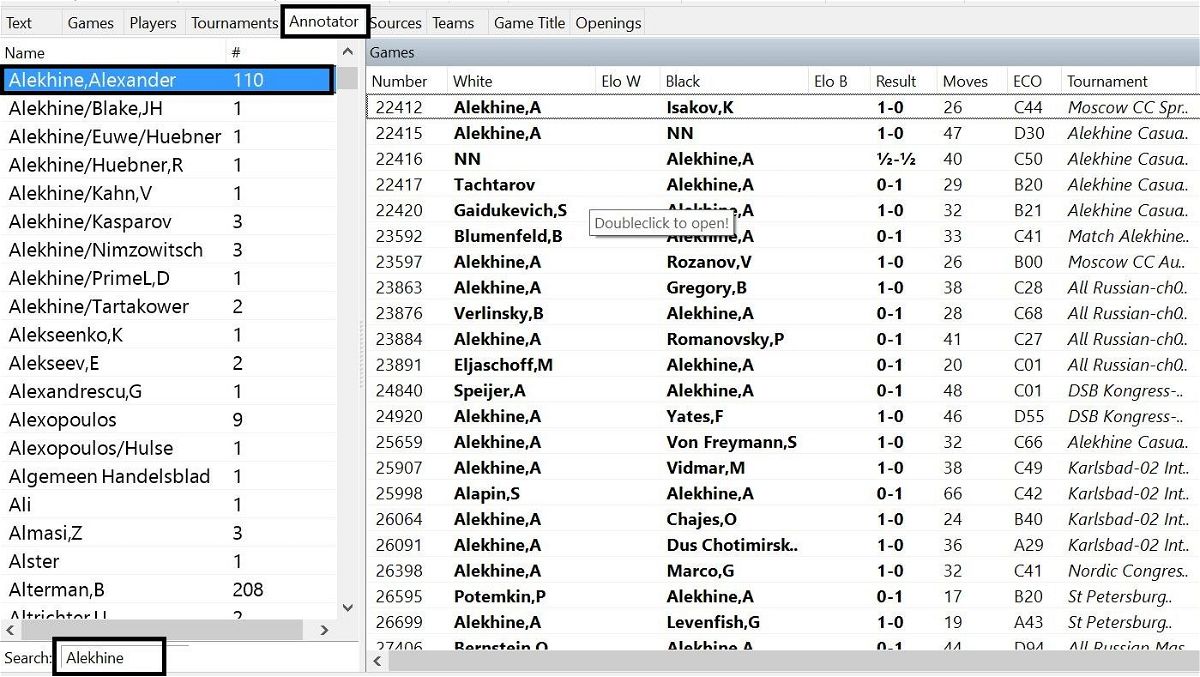
Out of curiosity, I typed the names of GM Ftacnik and Marin (one of my favourites and realized that the Slovakian GM has annotated 4961 games, while the Romanian has 1500!
I would like to show one last cool new feature. It's called the "Tactical analysis". It can be used to analyze a single game, or many games. If used for one single game one just needs to open the game, and go to the tab analysis.

The game will be automatically analyzed, and some training questions will be created. Chessbase 14 will also defines the type of endgame, and shows some of the strategical maneuvers of some of the pieces.
But the interesting part is not a one game analysis. During the day I play several games online, then at night, before going to sleep, I highlight the games I played, and want them analyzed.
It can take few hours, for this reason I do it at night, but in the morning when I wake up, I find the games ready for review, already labeled with medals, which indicate the type of tactics, sacrifices, or strategical maneuvers I can find inside, and of course with many training questions to solve for both sides. For example in the following position the blue arrows were created by the engine which analyzed the game, to show the strategic idea White had: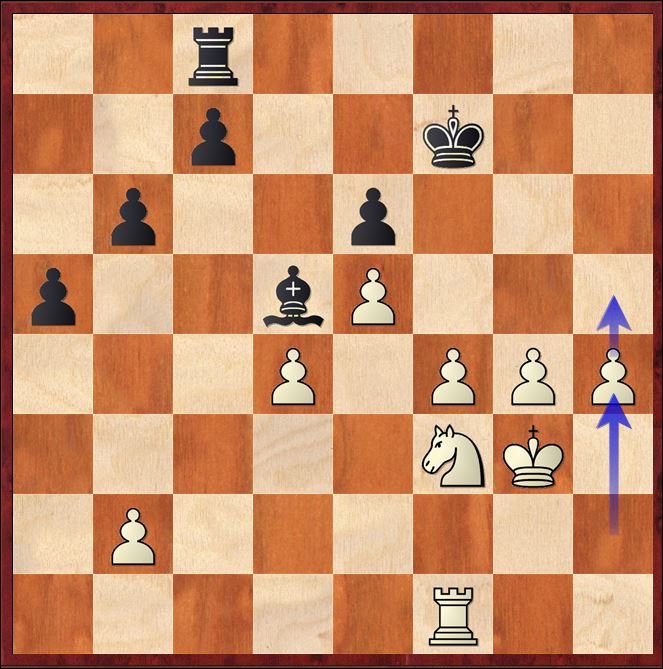
Once I open the game, going over it, I find some points where I need to guess the correct move, like in the following image:

And until I don't find the right move, the program doesn't let me continue to see the game, making this kind of training quite useful to see my common errors, and how to solve them.
The real advantage of this training is that it helps us find improvements in our own games. We also realize the type of middlegames and endgames we should focus our training on. Such training should be based on the themes, and patterns we would encounter originating from our opening repertoire. We would learn watching games of great masters, but nothing leads to faster improvement than learning from your own games. The best way is that we save our games in ChessBase 14, then we ask the engine to analyze them, and the engine creates training questions, that is quite an interactive, and a focused way of learning!
Time to close this review: ChessBase 14 is an essential tool every serious student must have, in order to progress on his chess journey. I Hope you will enjoy this new Chessbase 14, as much I'm enjoying it now! And at the same time reap the benefits of its tools for your chess progress.
- Buy ChessBase 14 from the Online Shop for just Rs.2999/-
- Buy Mega Database 2017 for Rs.4999/-
- Save Rs.1000 for ChessBase 14 + Mega Database 2017 combo for Rs.6999/-
About the Author

Davide Nastasio is a novel chess aficionado, who has made of chess his spiritual tool of improvement, and self-discovery. One of his favorite quotes is from the great Paul Keres: "Nobody is born a master. The way to mastery leads to the desired goal only after long years of learning, of struggle, of rejoicing, and of disappointment..." He is one of the main writers for ChessCafe on Chessbase products, he authors articles on British Chess Magazine, and he is one of the main contributors of Georgia Chess Magazine in the new electronic format: Georgia Chess News. He is an active player, and organizes and directs chess tournaments.
